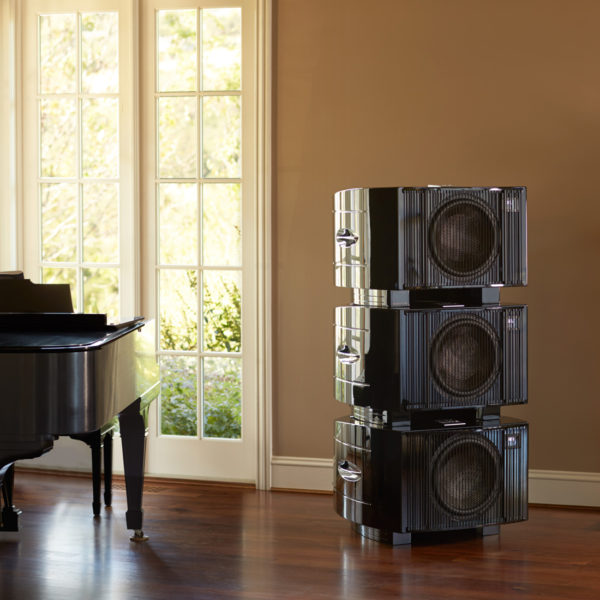Blog
Reference Line Arrays
The Story Behind The Stacks

My first CES, 1981 Chicago, Illinois and I felt like a kid in a candy store—from the main floor of McCormick Center where all the big Japanese brands were showing to the Pick Congress Hotel where the best high end audio brands showed in smaller hotel rooms—it was heady stuff for a 22 year old. Prowling the lower reaches of the Pick yielded some surprise finds, including one room that was a larger public room, the type used for conferences, of perhaps 20′ X 32’ dimensions. No signage was present, soft classical music emanated from the open double doors; as I walked up I recognized a Shostakovich Symphony playing and, as if on cue, at precisely the moment that I poked my head around the corner a gust of Herculean bass rolled out through the doors. Effortless and liquid, it was perhaps the first time I had encountered truly life-like bass.
Producing this was two stacked columns of distinctly unimpressive-looking woofer cabinets, think 60’s era AR bookshelf cabinets turned on their sides housing as 2” x 8” drivers/cabinet, perhaps 6-8 per side stacked almost floor to ceiling. These were supported by a pair of Acoustat Model 4’s – 4-panel electrostatic loudspeakers on custom-built stands that elevated them about 18”-24” and created an open sounding more balanced presentation of a speaker I had not previously loved. The sound staging was superb and the balance top-to-bottom was incredible, qualities I came to understand were consistently present when Dr. Keith Johnson (Entec’s chief designer) had a hand in system set-up and tuning. What I was hearing were early prototypes of what eventually became the Entec subs released some 3 years later. While the production subs never lived up to the warm musicality of those early prototypes, the experience remained buried within.
– 2010, Berkeley, California
Many years later, as my REL design team and I neared the successful completion of the original Gibraltar G-1, I flashed back to that early, formative experience and wondered what truly state of the art modern subs like the G-1 would sound like if used in stacked line arrays? How would something capable of truly deep, fast infra-bass do if the line array principle were applied? Would we generate too much cross-coupling amongst the drivers that we would end up with a huge wooly mammoth of a beast that lacked all subtlety and delicacy? As it turned out, this was one of the easiest projects to pull together, testimony to the basic goodness of the G-1 and even truer today of the modern No. 25 and MKII.
The Reference Line Array (RLA) produces several benefits; first, the bottom unit couples firmly with the floor producing the deepest bass, leveraging the largest support plane in the room—the floor. Think of the rumble of the largest pipes in a pipe organ as the purview of the bottom anchor unit. Moving vertically up the stack, the middle unit is responsible for the attack modes; lower-to-middle bass modes such as pistonic kick drums or aggressive special effects in movie sound tracks. Finally, the top unit–de-coupled fully from the floor and ceiling in most rooms– produces the light, feathery infra bass that only occurs in nature typically. These subtler shades of deep bass are responsible for the sense of vastness when we enter a large cavern or hall. Wired into our old brain, the uppermost unit communicates size, spatial detail, and decay patterns to a degree rarely encountered in a sound reproduction system of any size or price.
As we experimented with our first stack (cheerfully, if irreverently, referred to as a 6-pak) we quickly realized that using the existing feet for anything but the bottom units created several issues, including destroying the finish of the lower units. More importantly, while the feet worked beautifully to stabilize a single unit on the floor, they created instability when used on upper units. I set about experimenting with different heights—turns out that the height of the foot also did’t lend itself ideally to the RLA concept–and materials and after just a few rounds of prototyping our rails, we finally had a solution. 3 units, vertically stacked per side worked brilliantly when mated with our state of the art reference speakers. Further, it evolved that great speakers in the $25,000-40,000 range worked well with just 4 units (2 per side stacked).
The final design touch was a realization that we could clean up the visual clutter by adding daisy-chained nuts and outputs so as to allow just a single cable per stack and then distribute the additional upper subs from the bottom unit. And thus was borne the RLA or Vertical Stacking concept of REL Reference subs. If great ideas create copycat designs, it is gratifying to note that at last year’s Munich High End Show in Germany, we counted no fewer than 15 speaker companies showing with, or working on, their own attempts at the RLA.
However, critical to the performance of the RLA is separate gain and crossover settings for each sub. Tuning and optimization of each stack relies on being able to maximize the strength of each sub in its individual location within a stack. Copycat designs beginning to crop up tend use a single amp for each stack and thus most of the benefit of a true RLA is lost, the end result being powerful, but muddy bass.
Our unique use of high level connectivity, core to every REL subwoofer we make, coupled with precision gain and crossover control, gives the RLA a unique advantage over others. It allows each unit in the stack to be adjusted to perform its individualized task in perfect harmony with the speakers. It is this technology that has enabled us to produce the full and truly natural bass that first swept me off my feet in Chicago over three decades ago.
Enjoy the Music!
John Hunter
Owner & Sales/Design Director











